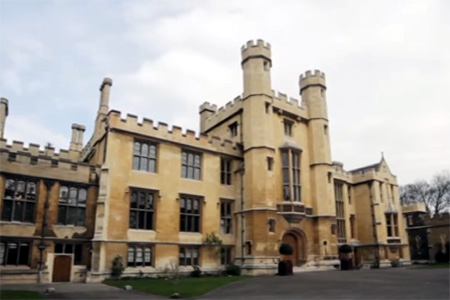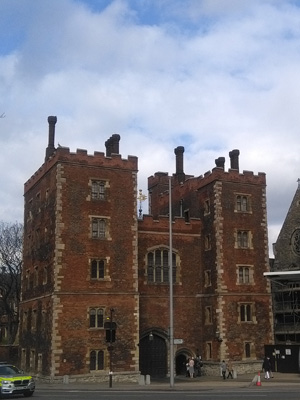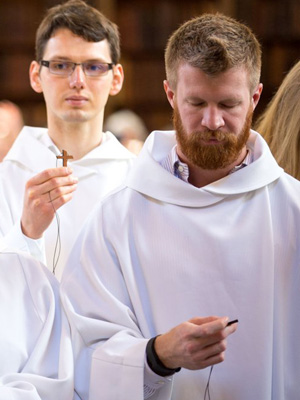| |
 |
 |
 |
| Comment on this report, or find other reports. |
 |
| Our Mystery Worshippers are volunteers who warm church pews for us around the world. If you'd like to become a Mystery Worshipper, start here. |
 |
| Find out how to reproduce this report in your church magazine or website. |
|
|
| 3141: Community of St Anselm, Lambeth Palace, London |
 |
 |
 |
Mystery Worshipper: Stan's Elm.
The church: Community of St Anselm, Lambeth Palace, London.
Denomination: Church of England. The Archbishop of Canterbury, the Most Revd and Rt Hon. Justin Welby, founded this ecumenical monastic community in 2015 as an opportunity for Christians aged 20-35 to spend a year in prayer, worship, study and service.
The building: From the street level, the first sight of Lambeth Palace that people get is of Mortonís Tower, a distinctive red brick building that has been in situ since the late 15th century. However, this only serves as the front door. Once inside, you reach a large courtyard and the front of the palace itself comes into view. The palace has been the official London residence of the Archbishop of Canterbury for nearly 800 years. As you come through the doors and up the stairs, you find yourself in a sumptuous corridor lined with portraits of former archbishops and the occasional large book (presumably a Bible or a prayer book) on display. We got the opportunity to peer into some of the rooms just off the corridor only momentarily, but all had tremendous grandeur. We spent some time in the guard room, which shows off a wonderful mix of ages, from the centuries-old arch braced roof to a set of chandeliers modelled on Orthodox oil lamps. These were presented to Archbishop George Carey in the 1990s by an American church. Heading down the stairs, one reaches the atrium, one of the most modern parts of the palace complex, opened in 2010 by the Prince of Wales. Itís a very light and airy space with a wonderful mixture of textures: glass, metal and stone. Half a level down from the atrium is the crypt chapel, where today's service was held. Itís a vaulted undercroft that dates back to the 13th century and was originally used for storing beer and wine. The crypt was first used as a chapel as a stopgap measure when the main chapel was destroyed during the Second World War, though it only became a permanent chapel in 1987. Itís a fairly small space, with the low vaulting giving it an unusually intimate feel.
The church: The community has its own rule of life, though there are two levels of membership: residential and non-residential. Around a third of the time of the residential community is spent working with charities and other local agencies to support and serve the poor and marginalised. The non-residents are expected to volunteer in a face-to-face capacity at least once a week.
Their most obvious visible presence comes from their brilliant white albs, which are so bright they wouldnít be out of place on a washing powder advert. On the hoods of the albs is small red cross, which distinguishes the wearers from the members of a similar Roman Catholic ecumenical community, Chemin Neuf, whom the Archbishop of Canterbury has invited to send a few members to reside at Lambeth Palace. Those who watched the proceedings of the last general synod will have seen the members of the community of St Anselm on the balcony of Church House, praying over the synod for its duration.
The neighbourhood: Lambeth Palace is right in the heart of London, situated on the south bank of the River Thames, just across the waterway from the Palace of Westminster and next door to St Thomasí Hospital. The London borough of Lambeth is largely residential, with the palace being located at the northernmost end where most of the boroughís tourist locations are located. These include the London Eye, the Imperial War Museum and the National Theatre. Next door to the palace is the Garden Museum, housed in the now deconsecrated church of St Mary, whose churchyard is the final resting place of William Bligh, who was captain of the merchant vessel HMS Bounty prior to the famed mutiny.
The cast: The service was led by Alan Morley-Fletcher, national leader of Chemin Neuf in the United Kingdom. I understand that this service is often led by Archbishop Welby, though we were informed that he was in Canterbury at the time, preparing for Holy Week.
The date & time: Tuesday, 4 April 2017, 5.30pm.
Comment:
We have received a comment on this report.
What was the name of the service?
Evening Prayer.
How full was the building?
There were a lot of guests in the chapel, having come from another event that took place within the palace earlier in the afternoon, so most seats were full. Some of the members of the monastic community knelt on the floor, some sat on the steps at the back of the crypt chapel. In total, there were about 40 of us there.
Did anyone welcome you personally?
Entering the grounds of the palace, I was met by a burly but friendly chap with a clipboard who ticked my name off a list. We had been asked to bring photo ID, but this was never checked. A young lady guided us through some of the labyrinthine corridors and down some stairs into the crypt chapel. There, we were met by two members of the monastic community, who handed us books and invited us to fill the chapel from the far side – an instruction that we duly heeded.
Was your pew comfortable?
We had very comfortable padded chairs. Not everyone used them, as some opted to sit or kneel on the chapel carpet or on a cushion.
How would you describe the pre-service
atmosphere?
It's hard to put my finger on. It was certainly quiet, but it wasn't deathly. It was a slightly unusual sight to see one or two members of the monastic community prostrate on the floor – more something one might expect to see in a highly charismatic church. With the monastic community already in the chapel, there was a slight feeling of "us and them" as the visitors came in, though this was in no way hostile – more curious than anything else. This feeling was added to by the fact that the members of the community were dotted around the edge of the room, while the visitors were slightly more towards the centre. The visitors spent some time looking around the chapel, which is a beautiful space. There was also a smell of fresh paint lingering in the air.
What were the exact opening words of the
service?
"Good evening. Thank you all for coming."
What books did the congregation use during the
service?
We had a booklet of liturgy that was taken from the 1662 Book of Common Prayer. We also had a small blue book of psalms. It didn't state what translation it contained, but it certainly wasn't a modern one. My guess would be the King James Version, but I might be wrong.
What musical instruments were played?
There were no musical instruments. We sang a couple of chants, which were led by a quite capable cantor, a member of the monastic community. At the top of each page there were four different tunes laid out in musical notation. As someone who can't read music, I found this rather intimidating, but the simple tunes were easy to pick up by ear.
Did anything distract you?
There was one chap, a visitor, sat over to my right who looked very much like a slim version of Penn Jillette, of the American magic act Penn & Teller. Not only was the likeness uncanny, but he was dressed in a three piece suit that matched the illusionistís on-stage appearance. Penn Jillette professes unabashedly to be an atheist – which made the "illusion" all the more distracting.

Was the worship stiff-upper-lip, happy clappy, or
what?
It was very, very liturgical! The service had a sort of order to it, though it was hard to follow as we jumped around from page to page within the main booklet. We sang the Magnificat and another chant that was less familiar. Prayers were offered for the victims of the recent terrorist attack on Westminster Bridge, which had taken place less than two weeks earlier just a few hundred yards from where we were sat. We also said prayers for the victims of other terrorist attacks and more generally victims of violence. Prayers were also said advocating peacefulness.
Exactly how long was the sermon?
No sermon.
Which part of the service was like being in
heaven?
There wasnít a moment, but there was a sense. The whole service was quite slow, deliberate and peaceful. There was no rush or bustle; had the service gone on for more than the half hour it lasted, then I doubt anyone would have noticed. It was a place filled with a spirit of devotion, but the prayers retained an outward focus, avoiding the possibility of it becoming too introspective. Consequently, it felt like it had just the right balance.
And which part was like being in... er... the other place?
The format for reading the psalms was a little odd. One half of the room read aloud the odd numbered verses, while the other half of the room read the even numbered verses. Each verse was split into two, with a pregnant pause between the two halves, which led to several people getting a bit lost and sometimes jumping in a little bit early. It was clear there was a kind of poetic intent behind reading them in this manner, but it was a bit convoluted and ended up detracting from the actual words being read.
What happened when you hung around after the service looking lost?
We filed out quietly into the courtyard, and people generally dispersed. Some stopped to take photos of the buildings. As we left the grounds of the palace, I witnessed Margaret Sentamu, the wife of the Archbishop of York, nearly get run over by a motorbike as she ran across the road.
How would you describe the after-service
coffee?
The coffee was served in another part of the palace before the service and was of a pretty high standard. It was served in fairly small, dainty cups, but there was ample opportunity for a refill.
How would you feel about making this church your regular (where 10 = ecstatic, 0 = terminal)?
8 – I'm almost too old to join the community, but if life circumstances changed and the opportunity arose, then I'd consider applying, even though I'm not an Anglican.
Did the service make you feel glad to be a
Christian?
It would be fair to say I was strangely warmed by the service.

What one thing will you remember about all this in seven days' time?
The dazzling albs. |
|
|
 |
 |
 |
| We rely on voluntary donations to stay online. If you're a regular visitor to Ship of Fools, please consider supporting us. |
 |
 |
 |
| The Mystery Pilgrim |
 |
| One of our most seasoned reporters makes the Camino pilgrimage to Santiago de Compostela in Spain. Read here. |
 |
 |
 |
| London churches |
 |
| Read reports from 70 London churches, visited by a small army of Mystery Worshippers on one single Sunday. Read here. |
| |
|
|
|
|


